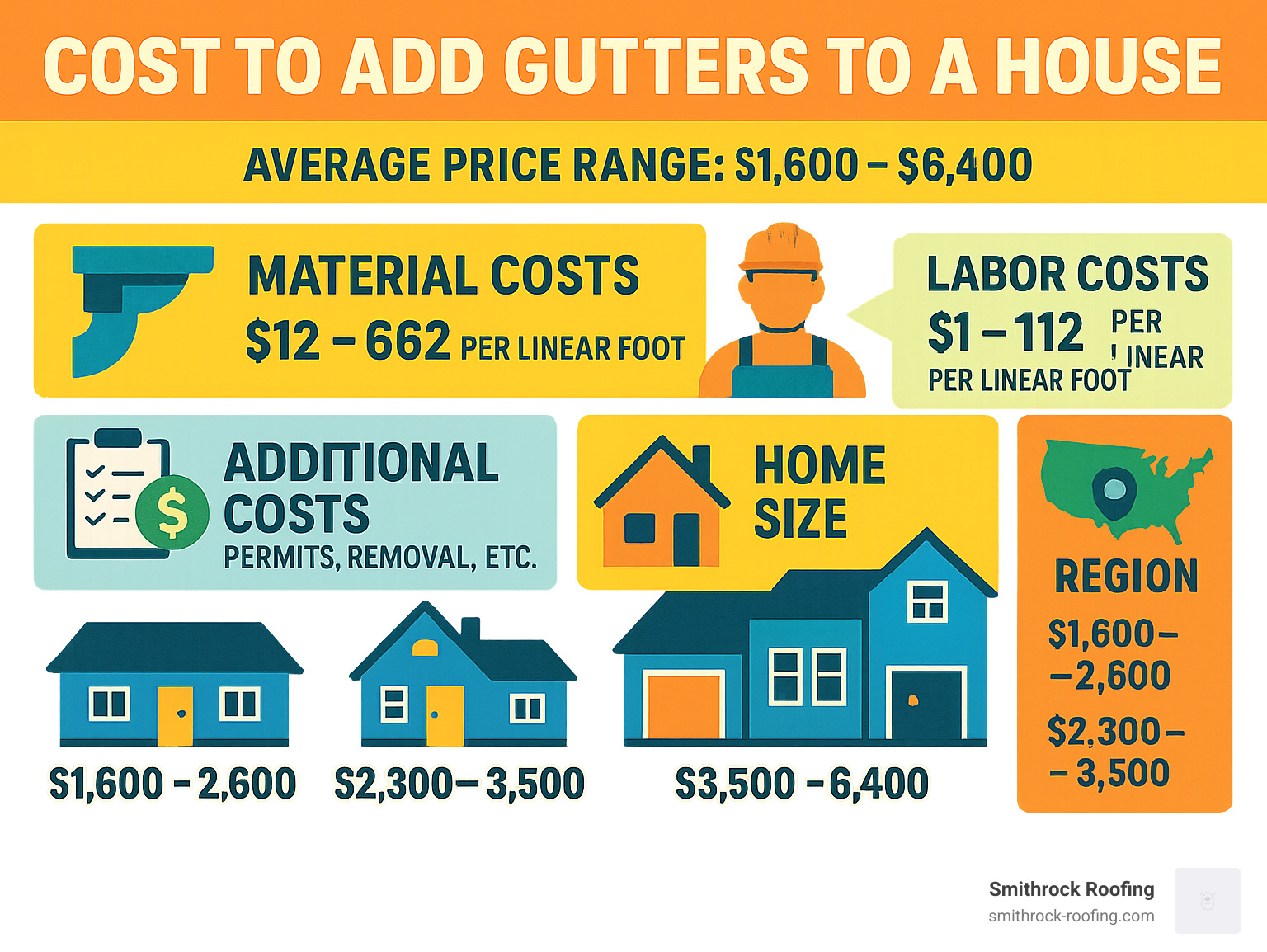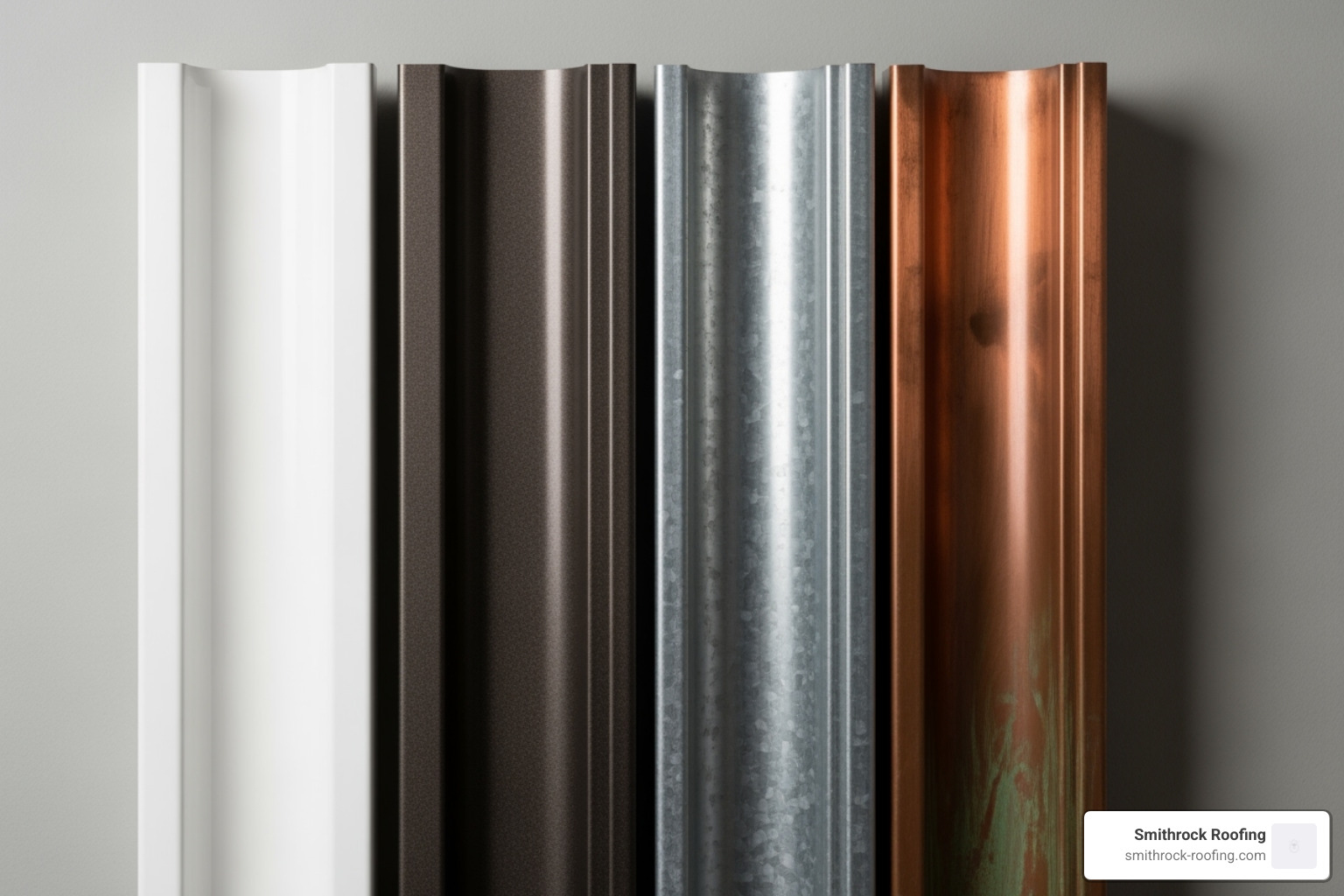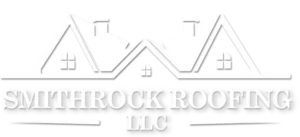The cost to add gutters to a house typically ranges from $1,600 to $6,400 for a complete installation, with most homeowners paying around $2,300 to $3,500. Here’s what you can expect:
Quick Cost Overview:
Let’s be honest – getting that first quote for new gutters can feel like a punch to the gut. One homeowner shared their experience: “My house has no gutters except for a small section over the back door… one seamless gutter company quoted me about $3,500 for the gutters and $2,500 for the mesh guards on top. So $6,000 total to put gutters on the house. I feel like that’s high.”
You’re not alone in feeling sticker shock. But here’s the thing – gutters aren’t just a nice-to-have feature. They’re your home’s first line of defense against water damage that can cost tens of thousands to repair.
Without proper gutters, rainwater cascades directly off your roof onto your foundation, creating problems like basement flooding, soil erosion, and even structural damage. The average cost to repair foundation issues? That can easily hit $10,000 or more.
Why do gutter costs vary so much? Several factors drive the final price: your home’s size and complexity, the material you choose, regional labor rates, and whether you need additional features like gutter guards or fascia repairs.
I’m Jordan Smith, and I’ve been helping homeowners steer exterior construction decisions for over 15 years. Through my experience with Smithrock Roofing, I’ve seen how understanding the true cost to add gutters to a house helps families make informed decisions that protect their biggest investment. Let me walk you through everything you need to know to budget smartly and avoid overpaying.

Key terms for cost to add gutters to a house:
Let me be straight with you – understanding the cost to add gutters to a house shouldn’t feel like you need a math degree. But here’s the reality: most homeowners end up spending between $2,500 and $3,500 for a complete gutter system, though the full range can stretch from $2,834 to $5,170 for a typical 2,500 square foot home.
That breaks down to roughly $14.17 to $25.85 per linear foot. Notice I said “per linear foot” – not per square foot of your home. This is where many homeowners get confused when trying to calculate costs on their own.
Here’s the thing about gutter pricing: it’s not just about slapping some aluminum channels on your roof edge and calling it a day. The total project cost includes materials, labor, disposal of old gutters (if you have them), potential repairs to your fascia board, downspouts, and all the little hardware pieces that make everything work together seamlessly.
When contractors calculate your quote, they’re measuring the linear footage of your roofline – essentially the perimeter where gutters will be installed. A 2,000 square foot home might need around 150-200 linear feet of gutters, which could run you about $6,384 for the complete installation project. But a home with the same square footage but a more complex roofline could need significantly more linear footage.
Getting multiple quotes isn’t just smart – it’s essential. I can’t tell you how many homeowners have shared horror stories about high-pressure sales tactics. One person told me their experience “felt like I was at a timeshare presentation” when a salesperson tried to rush them into signing that day.
Don’t let anyone pressure you into an immediate decision. Reputable contractors will provide detailed, itemized estimates and give you time to think it over. We always recommend getting at least three quotes from different companies. This lets you compare not just pricing, but what’s actually included in each estimate.
A quality estimate should break down material costs, labor fees, disposal charges, and any additional work needed. If someone gives you a vague “all-in” price without details, that’s a red flag.
For more comprehensive pricing data, you might want to check out How Much Does It Cost to Replace Gutters? [2025 Data] to see how your quotes compare to national averages.
Your home’s size and architectural personality play huge roles in determining the cost to add gutters to a house. It’s not just about how many square feet you have – it’s about how complicated your roofline is and how much of a challenge it presents to installers.
Linear footage is king when it comes to gutter pricing. A typical American home needs somewhere between 100 to 200 linear feet of guttering. Think about it this way: a simple, rectangular ranch-style house might only need 100 to 150 linear feet. But a two-story home with dormers, bay windows, and multiple roof sections? You’re looking at 200 to 300 linear feet or more.
Single-story versus multi-story homes make a big difference in your final bill. Installing gutters on a two or three-story home isn’t just more dangerous – it requires specialized equipment, taller ladders, sometimes scaffolding, and installers who are comfortable working at height. All of this translates to higher labor costs. To put this in perspective, just cleaning gutters on a three-story home costs $170 to $425 compared to $70 to $200 for a single-story home.
Roof pitch and complexity can really drive up costs. A steep roof pitch makes everything more challenging and dangerous for installers. But the real cost drivers are all those architectural details that make your home unique – dormers, gables, valleys, and corners. Each corner requires a custom miter cut, and every roof valley needs special attention to ensure proper water flow.
Accessibility issues around your home can also bump up the price. Beautiful landscaping, privacy fences, or that gorgeous deck you built might look great, but they can make it harder for installers to get their equipment close to your house. When crews have to work around obstacles or carry materials longer distances, it adds time and effort to the job.
The bottom line? Complex rooflines require more materials, more custom cuts, and more skilled labor – all of which show up in your final invoice.
Labor typically represents the biggest chunk of your cost to add gutters to a house – usually about 40% to 60% of your total project cost. Professional installation generally runs $1 to $12 per linear foot, or $50 to $70 per hour. For most homes, you’re looking at $1,000 to $2,500 just for labor.
Where you live makes a huge difference in labor costs. We’ve seen prices vary dramatically across the country – from $3.42 per linear foot in Tennessee all the way up to $10.50 in Idaho. Even in Canada, cities like Ottawa see ranges from $6 to $12 per linear foot. Here in North Carolina, particularly around Winston-Salem, King, and Clemmons, we work hard to keep our pricing competitive while maintaining the quality workmanship our customers deserve.
Experience and reputation matter when choosing a contractor. You might pay a bit more for a highly experienced crew, but their expertise shows in the final product. They understand the critical details – proper pitch for water flow, secure attachment methods, and precise alignment. These aren’t just nice-to-haves; they’re what prevent leaks and ensure your gutters last for decades.
Safety is non-negotiable in gutter installation. Working at heights carries real risks, and professional installers have the training and equipment to do the job safely. They know ladder safety, fall prevention techniques, and how to handle materials at elevation without damaging your home or injuring themselves.
Always verify that your contractor is properly licensed, insured, and bonded. This protects both you and them if something goes wrong during installation. Don’t be shy about asking for proof of insurance or checking their licensing status with your state’s contractor board.
For more details on what professional installation includes, take a look at our comprehensive guide on professional Gutter Installation.
Here’s where many homeowners get surprised – the cost to add gutters to a house often includes several additional expenses beyond the basic per-linear-foot price. Let me walk you through the most common add-ons so you can budget accordingly.
Removing and disposing of old gutters isn’t free. If you’re replacing existing gutters, expect to pay $1 to $2 per linear foot for removal, plus another $100 to $300 for proper disposal. Some contractors include this in their base quote, others list it separately. Always ask upfront what’s included.
Fascia and soffit repairs can be a significant unexpected expense. The fascia board runs along your roof edge where gutters attach. If it’s rotted, warped, or damaged from years of water exposure, it must be fixed before new gutters go up. This carpentry work can add hundreds or even thousands to your project cost, depending on how extensive the damage is.
The roof overhang structure needs to be solid and properly aligned to support your new gutters. Any structural issues here need attention before installation begins.
Downspouts and extensions are essential but often priced separately. Most homes need one downspout every 30 to 40 feet, so count on 4 to 5 downspouts for a typical house. Prices vary dramatically by material – from $97.51 for vinyl to $588 for copper per downspout.
Don’t forget about downspout extensions or splash blocks. These direct water at least five feet away from your foundation, preventing erosion and potential basement flooding. They typically cost $10 to $50 per extension, but they’re worth every penny for foundation protection.
Gutter guards are a popular add-on that can cost $5 to $10 per linear foot, with total installation running $460 to $4,000 for a complete system. We’ll discuss whether they’re worth it later, but know they represent a significant upfront investment.
Heat tape becomes important in cold climates where ice dams are common. If you live in an area with harsh winters, this heating element can be installed along your gutters to prevent ice buildup. Expect to pay $10 to $20 per linear foot for this feature.
Permit fees might apply depending on your local building codes. While not always required for simple gutter replacement, some municipalities require permits, especially if the work is part of a larger roofing project. These typically run $50 to a few hundred dollars. Check with your local building department – whether you’re in Winston-Salem, Greensboro, High Point, or surrounding areas – to understand what’s required in your specific location.
The material you choose for your gutters is arguably the most significant factor influencing the total cost to add gutters to a house. It’s like choosing the foundation for your home’s water management system – get it right, and you’ll enjoy years of worry-free protection. Get it wrong, and you might find yourself dealing with frequent repairs or premature replacement.

Think of it this way: your climate is your biggest decision-maker. Here in North Carolina, we see everything from scorching summer heat to occasional ice storms. What works beautifully in Arizona’s dry heat might crack under our humid summers and freezing winters. That gorgeous copper system that looks stunning on a historic home in Charleston might be overkill for a starter home in Clemmons.
Aesthetics matter too, but they shouldn’t drive your decision alone. I’ve seen homeowners fall in love with the look of wood gutters, only to realize the maintenance requirements don’t fit their lifestyle. The key is finding that sweet spot where durability meets your budget and complements your home’s style.
Let me walk you through the options so you can make an informed choice that you’ll be happy with for decades to come.
Understanding the cost differences between gutter materials helps you budget effectively and choose the best option for your situation. Here’s what you can expect to pay for different materials, along with their typical lifespan and key characteristics:
| Gutter Material | Cost per Linear Foot | Lifespan | Pros | Cons |
|---|---|---|---|---|
| Aluminum | $4-$12 | 20-25 years | Lightweight, rust-resistant, paintable, affordable | Can dent easily, expands/contracts with temperature |
| Vinyl | $3-$8 | 10-15 years | Most affordable, easy DIY installation, won’t rust | Becomes brittle in cold, limited color options, shorter lifespan |
| Steel | $8-$16 | 15-25 years | Very strong, handles heavy snow/ice well | Prone to rust over time, heavier installation |
| Copper | $15-$30 | 50+ years | Beautiful patina, extremely durable, adds home value | Highest upfront cost, requires skilled installation |
| Zinc | $12-$22 | 30-50 years | Self-healing properties, develops attractive patina | Expensive, limited installer availability |
Aluminum gutters represent the sweet spot for most homeowners. They offer excellent value, lasting 20-25 years while handling our North Carolina weather beautifully. At $4-$12 per linear foot, they’re affordable enough for most budgets yet durable enough to protect your investment.
Vinyl gutters might seem tempting at $3-$8 per linear foot, but their 10-15 year lifespan means you’ll likely replace them sooner. They work well in mild climates but can become brittle during our occasional cold snaps.
Steel gutters excel in areas with heavy snow loads or severe weather. While they cost more upfront ($8-$16 per linear foot), their strength makes them worth considering if you live in an area prone to falling branches or hail.
Copper and zinc gutters are premium options that can last 50+ years. Yes, the upfront cost to add gutters to a house jumps significantly, but they’re practically a lifetime investment. Copper develops a beautiful green patina over time, while zinc offers similar longevity with a more subtle appearance.
The choice between seamless and sectional gutters significantly impacts both your upfront costs and long-term satisfaction. Seamless gutters are custom-formed on-site using specialized equipment, creating continuous runs with joints only at corners and downspout connections. Sectional gutters come in pre-cut lengths (typically 10-20 feet) that are joined together during installation.
Seamless gutters typically cost 10-15% more upfront than sectional systems, but here’s why they’re often worth it: fewer joints mean fewer potential leak points. Every joint in a sectional system is a place where water can eventually find its way through. Over time, thermal expansion and contraction, settling, and normal wear can cause these joints to separate slightly.
The leak potential difference is significant. Seamless gutters might develop leaks at corners or downspout connections, but sectional systems have joints every 10-20 feet. That means a 150-foot gutter run might have 7-15 potential leak points with sectional gutters versus just 4-6 with seamless.
Durability favors seamless systems too. Without multiple joints to stress and separate, seamless gutters typically last longer and require less maintenance. The continuous material also provides better structural integrity, especially important during heavy rainfall or when gutters fill with debris.
However, sectional gutters offer easier DIY installation and replacement. If a section gets damaged, you can replace just that piece rather than reforming an entire run. For homeowners comfortable with DIY projects, sectional gutters provide more flexibility.
Professional equipment is required for seamless gutters – the forming machines are expensive and require training to operate properly. This means seamless installation is essentially a professional-only job, while motivated homeowners can tackle sectional installations themselves.
For more detailed information about seamless options, check out Fixr Seamless gutters for additional cost breakdowns and considerations.
Let’s dive deeper into the most common gutter materials you’ll encounter when researching the cost to add gutters to a house.
Vinyl gutters are the budget-friendly option, appealing to cost-conscious homeowners and DIY enthusiasts. They won’t rust, are easy to cut and install, and come in basic colors like white, brown, and sometimes black. However, UV exposure can make them brittle over time, and extreme cold can cause cracking. They’re best suited for mild climates and homes where budget is the primary concern.
Aluminum gutters dominate the residential market for good reason. They’re lightweight enough for easy installation yet strong enough to handle normal weather conditions. Aluminum naturally resists rust and can be painted to match your home’s trim. The main drawback is their tendency to dent from hail, falling branches, or ladder contact during maintenance.
Galvanized steel gutters offer superior strength, making them ideal for areas with severe weather or homes with large roof areas that channel significant water volumes. They handle snow loads better than aluminum and resist denting. The trade-off is weight (requiring stronger fascia support) and eventual rust, especially at cut edges and joints.
Copper gutters are the premium choice, offering best longevity and distinctive beauty. They start bright and shiny, gradually developing a green patina that many homeowners love. Copper naturally resists corrosion and can last 50-100 years with minimal maintenance. The high cost limits their use to upscale homes or historically appropriate applications.
Zinc gutters provide similar longevity to copper with a more subtle appearance. They develop a matte gray patina and have “self-healing” properties – minor scratches actually seal themselves over time. Like copper, zinc requires skilled installation and represents a significant investment.
Wood gutters deserve mention for historic homes or specific architectural styles. While beautiful and historically accurate, they require regular maintenance including cleaning, sealing, and eventual replacement. For detailed pricing on wood gutters, Homewyse Calculator: Wood Gutter prices, options and installation costs provides comprehensive cost breakdowns.
The key is matching your material choice to your specific situation – climate, budget, home style, and maintenance preferences all play important roles in making the right decision for your cost to add gutters to a house project.

Smithrock Roofing © Copyright 2025 • All Rights Reserved • Privacy Policy • Maintained by Mongoose Digital Marketing